This site contains affiliate links to products. We may receive commission for purchases made through these links. Price at time of publish date may change.
Leaving cell service behind means leaving your lifeline behind. A good hiking GPS becomes your lifeline, and a way to call for help if things go wrong. Modern hiking GPS units have come a long way from basic mapping tools – they now have satellite messaging, detailed maps and emergency alerts.
How to Choose a Hiking GPS
What do you really need? Here’s what to look at:
Size and Weight: You’ll be carrying this on long walks so every ounce counts. Smaller units are easier to pack but have smaller screens.
Battery Life: Nothing’s worse than a dead GPS when you need it most. Look at how long the battery lasts and what type it uses – some need special batteries and others use regular AA ones.
Maps and Navigation: Basic units show simple routes, better ones have detailed topographic maps. What kind of trails will you be using it on?
Extra Features: Some let you send messages through satellites, mark specific points on your route or connect to your phone. What extras matter to you?
Price: Hiking GPS units range from $130 to over $400. More expensive doesn’t always mean better – it depends on what you need.
Meet Our Picks
- Best Overall: Garmin inReach Mini 2 – Perfect mix of small size and safety features
- Best Value: Garmin eTrex 22x – Great basic navigation at a good price
- Basic Pick: Garmin eTrex 10 – Simple but reliable
- Alternative Choice: Bushnell Phantom 3 – Good for both hiking and golf
Why You Should Trust Us
Our recommendations come from a advanced review analysis system that’s different from traditional product testing. While other reviews are based on short term testing, our system uses long term user experiences and big data.
Our proprietary algorithm analyzes thousands of verified purchase reviews daily, looking at patterns in user satisfaction, reliability reports and performance metrics. We focus on reviews from consumers who have used products for months, to get insights into durability, maintenance needs and hidden costs that only show up after months of use.
to ensure accuracy our system:
- Filters out fake reviews using AI pattern recognition
- Prioritizes verified purchases with photo/video proof
- Tracks product performance in different usage scenarios
- Monitors customer service responses and warranty claims
- Updates recommendations based on new user experiences
Our team cross checks findings with industry experts and certified testing labs to ensure our recommendations match professional standards while reflecting real world usage. This combination of data analysis and expert validation means you can trust our recommendations to help you make informed buying decisions.
1 – The Winner
Garmin inReach Mini 2
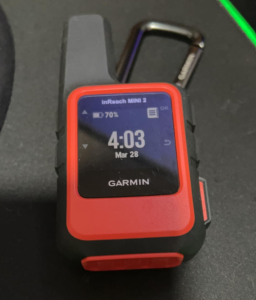
Photo: Amazon
Why We Chose It
The Garmin inReach Mini 2 is our top pick for serious hikers. This little orange thing is packed with features and won’t weigh you down in your backpack.
It excels at keeping you connected when you’re off the grid. Unlike a basic GPS, the inReach Mini 2 lets you send messages to your loved ones from anywhere using the Iridium satellite network. You can share your location at any time on your personal MapShare page or include your coordinates in a message.
For navigation it has features like TracBack routing which helps you find your way back to where you started – super useful if you get turned around on the trail. The digital compass gives you heading information even when you’re standing still, unlike cheaper units that only work when you’re moving.
It pairs well with your smartphone through the Garmin Explore app. This lets you plan trips, look at detailed maps and set up waypoints before you head out. You can also connect it to other Garmin devices like watches so you can check messages or call for help without pulling out the main unit.
It lasts up to 2 weeks on a single charge when set to track every 10 minutes. No need to worry about charging on weekend trips or longer trips.
2 – Best Value
Garmin eTrex 22x
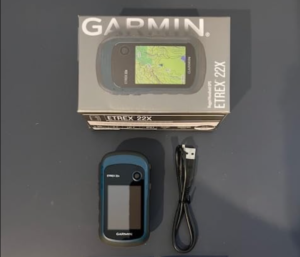
Photo: Amazon
A Solid Mid-Range Option
You don’t need to break the bank to get a good hiking GPS. The Garmin eTrex 22x finds the sweet spot between features and price. Perfect for regular hikers who want good navigation without satellite messaging.
It comes preloaded with Topo Active maps. These maps show roads and trails so you can use it for hiking and biking without buying extra map packs. 8GB of internal memory and you can add more with a micro SD card if you need to.
What makes this unit stand out is how it performs in different conditions. The screen is readable in bright sunlight which is important when you’re checking your location on sunny days. It uses both GPS and GLONASS satellite systems so it will track your position even in areas where basic GPS units will struggle, like deep valleys or dense forest.
The eTrex 22x runs on 2 AA batteries and will last around 25 hours of normal use. Great for longer trips since you can just pack extra batteries instead of finding a place to charge. Users like how it fits in one hand and works with light gloves on.
3 – Basic Pick
Garmin eTrex 10
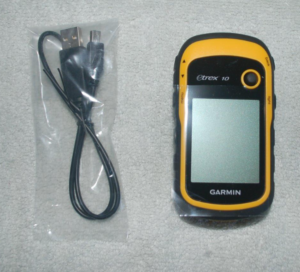
Photo: Amazon
The No-Frills Navigator
The Garmin eTrex 10 proves that sometimes less is more. This basic hiking GPS removes all the bells and whistles and gets back to what matters most – knowing where you are and how to get back home.
What sets this device apart is its reliability. The black and white screen may look old school but it serves a purpose. This basic display allows the device to run longer on batteries than a color screen. When you’re on the trail you want to know your GPS will work more than you want pretty maps.
The eTrex 10 uses both GPS and GLONASS satellites to determine your location. This dual-system approach means it can find you in about 40 seconds from a cold start even on cloudy days. Users report getting readings within 5 feet even with trees and buildings nearby.
For navigation it’s simple. It shows you where you are, tracks where you’ve been and helps you mark points along your route. It’s water resistant to rain and splashes and the rugged case can take some bumps without breaking.
The control stick is great for hikers as you can use it with gloves on – a big plus for cold weather hiking. It stores points like highest and lowest elevation along your track so you can plan future hikes.
4 – Alternative Choice
Bushnell Phantom 3
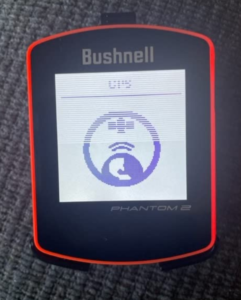
Photo: Amazon
A Different Approach
The Bushnell Phantom 3 takes a unique spot on our list. While it’s mainly for golf, some hikers like the simplicity of distance tracking and big display for trail walking too.
This one stands out with practical design choices. The screen has bigger numbers than most GPS units so you can check distances without having to stop and squint at tiny text. The strong magnet mount meant for golf carts works just as well on hiking poles or metal water bottles.
Battery life is good for 18 hours of use. It uses a USB-C charging cable – the same kind many phones use – so you don’t need to carry special chargers. This common charging option makes it much easier to stay powered up on long trips.
The auto advance feature, though meant for golf holes, can be useful when moving between trail markers or waypoints. It tracks up to 6 different distance points at once so you can keep track of landmarks along your route.
Which Hiking GPS to Buy?
The hiking GPS you should buy depends on what you do outdoors. Here’s how to choose between our options:
Get the Garmin inReach Mini 2 if safety is your number one priority. At $294.31 it’s more expensive than the others but being able to send messages from anywhere and call for help is worth the cost for serious hikers who go to remote areas. Just remember you’ll need to pay for a subscription.
Get the Garmin eTrex 22x if you want value. At $159.99 it gives you solid navigation and a color screen that’s easy to read outside. Perfect for day hikers and weekend backpackers who need reliable navigation without satellite messaging.
Get the Garmin eTrex 10 if you just want something that works. For $139.90 you get a simple but reliable device that runs forever on AA batteries. Good for hikers who care more about battery life than fancy features.
Look at the Bushnell Phantom 3 if you want something different. At $134.99 it’s the cheapest option and while it’s not made for hiking it has a clear screen and simple distance tracking that works on trails. Good for casual hikers who also golf.
For most people venturing into the backcountry the Garmin inReach Mini 2 is the way to go. Satellite messaging could literally save your life and it’s small enough you’ll actually carry it with you. The eTrex 22x makes more sense if you hike in areas where you don’t need emergency communication.
Hiking GPS FAQ
Do I really need a hiking GPS if I have a smartphone?
Yes, if you hike in remote areas. Hiking GPS devices work without cell service, have better battery life and are more durable than phones. Many also have satellite messaging that phones don’t.
How accurate are hiking GPS devices?
Most modern hiking GPS units are accurate within 10-20 feet. Units that use both GPS and GLONASS satellites, like our picks, are accurate within 5-10 feet.
What’s the difference between a hiking GPS and a regular GPS?
Hiking GPS devices are tough, waterproof and have long battery life. They often have topographic maps, trail markers and elevation tracking that regular GPS units don’t.
Do I have to pay for maps?
It depends on the device. The eTrex 22x comes with basic topo maps included. Some devices let you download free maps, others require you to buy maps separately.
How long do the batteries last?
Battery life varies:
- inReach Mini 2: Up to 14 days in tracking mode
- eTrex 22x: 25 hours with AA batteries
- eTrex 10: 20 hours with AA batteries
- Bushnell Phantom 3: 18 hours
Can I use my hiking GPS in bad weather?
Yes. All our picks are weatherproof and can handle rain and rough conditions. They’re much more durable than regular electronics and work in cold weather too.
Do I need a subscription for my hiking GPS?
Only if you want satellite communication features. The inReach Mini 2 needs a subscription for messaging and SOS features. Basic navigation works on all devices without a subscription.
Can I mark spots on my trail to find them later?
Yes, all these devices let you mark waypoints. You can mark trailheads, campsites, water sources or any other spot you want to find again.
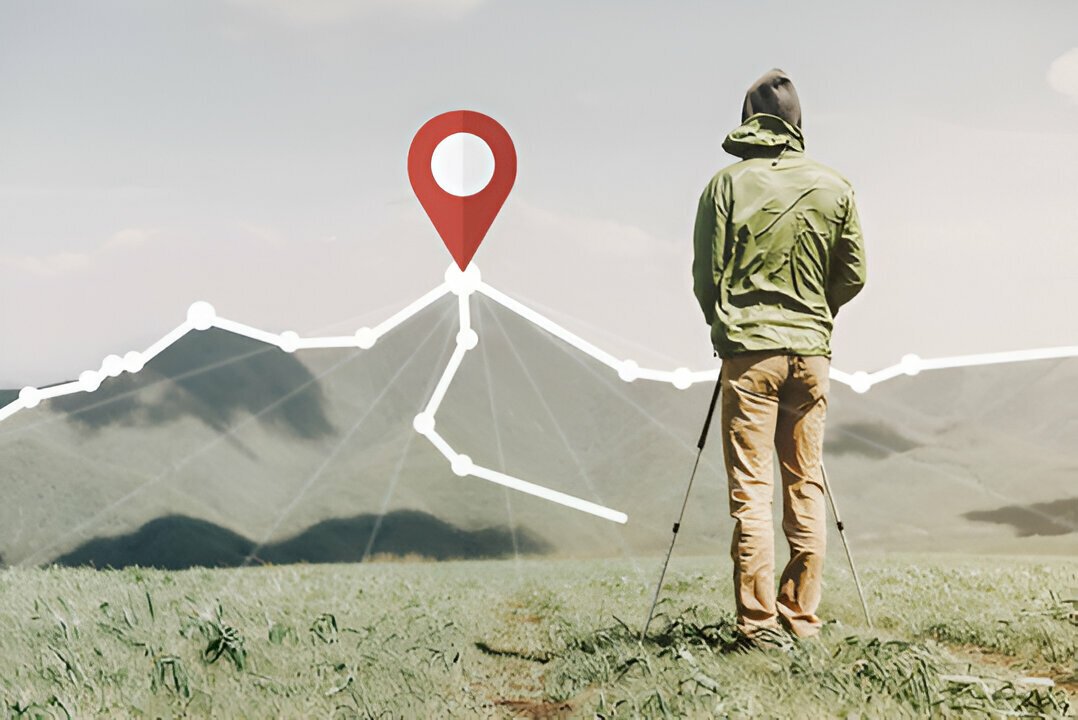

2 thoughts on “The 4 Best Hiking GPS Devices”